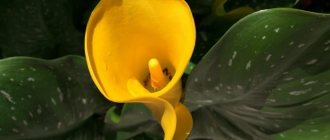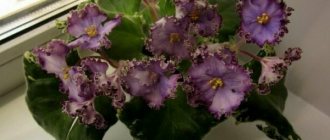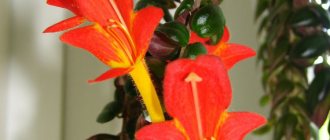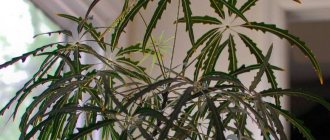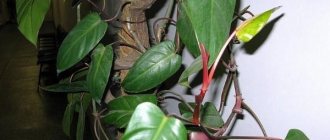Types of chlorophytum
The plant arrived in Europe 200 years ago from the subtropics of Africa and Latin America. This is a flower with stringy roots and a variegated cap of elongated lanceolate leaves of various colors. Of the many plant species, the most common ones should be noted:
- Tufted is a compact but growing bush with leaves growing from the center, resembling a tuft. The middle part of the leaf is pale yellow, the edges are green, in the form of a narrow strip. The flowers are small greenish in color on a high peduncle;
- Curly - the shape and color of the leaves are similar to crested chlorophytum, but they become rounded as they grow, in the form of curls. Therefore, the bush takes on a spherical shape;
- Cape is a simple variety of chlorophytum with leaves of intense yellow color.
- Chlorophytum Blue Pearl is a pearl among flower varieties. Quite unlike a traditional flower, the plant consists of long hanging strands of blue cones located along the entire length of the stem. An unusual and mesmerizing blue waterfall attracts attention.
Caring for chlorophytum at home
Chlorophytum is one of the flower crops that can be cared for by a novice gardener. Watering, fertilizing and annual replanting are the main stages of year-round care for chlorophytum.
You can place the flower anywhere in the room, but it grows best on western and eastern windows. The color of the leaves and their elasticity will be more intense. But if you place a pot with a flower in a darker place, it will also grow and bloom, only less actively.
Watering
If you often travel or forget to water your plants, chlorophytum is an ideal specimen for your apartment. Its roots absorb moisture and retain it for a month. Watering should be regular and moderate. Periodically spray the leaves, give your pet a shower and wipe the leaves of the flower from dust with a sponge or cotton wool soaked in water. The plant will respond to care with brightly colored leaves and flowering.
Top dressing
Like any plant, chlorophytum needs nutrients for growth and development. Any complex mineral fertilizer for decorative foliage plants or universal fertilizer for indoor flowers, used in accordance with the instructions, will be beneficial. In summer it is enough to feed once every 10-13 days, in winter - once every 25-30 days.
Trimming
The flower does not require special pruning, except for removing diseased and old leaves. If you want to shape the crown or remove a cascade of rosettes, you can trim periodically. Although, descending small rosettes of chlorophytum give the flower beauty and elegance, and perhaps some playfulness.
Transfer
It is better to replant an adult plant in the spring into a spacious pot, since under normal conditions the flower develops quickly and builds up the root system and green mass.
Reproduction methods
Like many plants, chlorophytum can reproduce in three ways: by dividing the bush, by seeds and by lateral shoots (also known as offshoots). Planting seeds at home is not the most convenient and effective method, so the easiest way to propagate chlorophytum is by dividing the bush and children; growing seeds is suitable for more experienced gardeners.
Dividing the bush
As it grows, chlorophytum reaches large dimensions. The pot in which the plant is kept becomes too small over time. On average, once a year it is necessary to divide the bush to get a new plant and give better conditions to the old one. Since chlorophytum has one of the most powerful root systems among indoor plants, its division does not cause difficulties. The bush is divided only in spring.
2-3 hours before dividing, you need to moisten the soil of the plant more than usual
This will protect the roots and allow the procedure to be carried out quickly. When the bush is removed from the pot, you need to free the roots from the remaining soil and carefully untangle them.
Then divide the bush into several parts. All that remains is to transplant the separated parts into a new container.
Reproduction by shoots
An adult chlorophytum plant forms several stems-peduncles, on which rosettes are formed. Some gardeners note that after separating such babies from the main plant, they should be kept in a glass of water for several days. After this, the shoots can be planted in a pot.
Before you start propagation, you should carefully choose the future home of the chlorophytum.
You need to take into account the rapid growth of this flower. Considering that the plant will have to live in a pot for the entire next year without replanting, you need to make sure that the container is of the appropriate size
It is worth noting that not all varieties of chlorophytum form lateral shoots on their shoots.
Growing seeds
When preparing for the procedure, you need to understand that more than half of the seeds do not germinate at all, so you should not expect supernatural results. Before planting, the seeds should be covered with a thin layer of cotton wool and kept in a glass of water for a day, regularly changing the liquid to fresh (every 3-4 hours). The soil, which should contain peat and sand, must be moistened by the time the cotton wool seeds are planted. The top of the container with seeds must be covered with glass or polyethylene. You need to move the container to a warm and dark place and ensure the temperature is 25 degrees, maintaining it constantly.
It is necessary to frequently open and ventilate the soil, as well as spray. After about 30 days, with proper care, sprouts will appear. By gradually increasing the ventilation time, after 10-14 days you can free the container with hatched seeds from the film.
Reproduction of chlorophytum
Chlorophytum is one of those plants that easily reproduce and take root. The easiest way is propagation by rosettes. Small, cascading rosettes need to be carefully cut off and placed in water. After some time, the rosette will give roots, and it can be transplanted into containers for seedlings.
If the flower bush has grown, you can propagate it by dividing the bush. Dividing the bush must be done carefully so as not to damage the numerous roots. You can also propagate the plant by crown rosettes, which grow separately a little further from the main rosette. Rosettes with roots must be immediately planted in the soil and watered.
If you want to breed rare varieties of plants, you can purchase seed material, soak it for a day in a growth stimulator and sow it on the surface of the soil. Moisten the soil by spraying and place in a mini-greenhouse (plastic bag). As the seedlings appear, remove the greenhouse, and in the phase of 2-3 leaves, pick the seedlings into separate containers.
Land for chlorophytum
By its nature, chlorophytum is an epiphyte that can survive on a wide variety of soil types. In order for this green pet to actively grow at home and delight you with its greenery, you need to pay attention to the soil:
- This can be any store-bought soil mixture for ornamental flower crops, a substrate for roses, palm trees and begonias. It is better if the soil is nutritious, moisture-absorbing with good aeration. In heavy soil, plant growth slows down, and the greenery does not look so juicy and lush.
- You can prepare the correct soil for the chlorophytum flower yourself. To do this, you need to mix leaf and turf soil, humus and sand in a ratio of 2:2:1:1. You can add a little bone meal, crushed coal or horn shavings to your homemade soil.
The magical properties of chlorophytum
Taking care of the owners is the main magical property of a flower. Absorbing all negative substances and cures, eliminating negative energy and cleansing the aura of the house, it brings health, mood, comfort, peace and tranquility to its inhabitants.
There is no family whose apartment window sills are not decorated with indoor flowers. Some people love plants that bloom profusely, while there are others who prefer evergreen beauty. Chlorophytum, whose stems hang majestically along the edges of flowerpots, will be an excellent decorative element of any living space. They themselves choose a suitable place for themselves in the new premises. There is a legend according to which the house will be full, with prosperity, prosperity, love, fidelity, mutual understanding, if you add chlorophytum to it first. It has such powerful energy that it is enough for all family members. In order for a flower to share its positive aura with others, you need to take good care of it.
Features of the flower
This plant is considered one of the most popular, preferring indoor conditions. It is very decorative and unpretentious. It is native to South Africa, where it can be seen hanging from the bark of trees. It somewhat resembles a bush with shortened stems and thickened roots, sometimes tuberous in shape. The plant is a perennial species. It reaches about half a meter in diameter, although meter-long specimens can be found in the wild. Tuberous thickened roots help the plant withstand prolonged drought.
Description of chlorophytum
The decorative deciduous herbaceous plant chlorophytum is considered one of the most unpretentious indoor flowers with many useful properties:
- From Latin, the name of the indoor flower chlorophytum is translated as “green plant.” However, due to its unusual appearance, the plant has more elegant folk names: spider flower, green lily, champagne splash and some others.
- In the wild, the plant lives in the tropics and subtropics of South America, Asia and Africa. At home, it is used to combat soil erosion by planting it on slopes and slopes to consolidate the soil.
- The plant was brought to Europe more than 200 years ago after the Swedish botanist Carl Thunberg first described it, classifying it as a member of the Liliaceae family. Modern scientists argue among themselves, attributing the flower to Asparagus or Agave.
- In the Soviet Union, the plant was very popular in homes due to its proven effectiveness in purifying and humidifying the air in the room. It is able to capture and process toxins, formaldehyde, carbon monoxide, and gradually release moisture accumulated in the leaves. Some housewives specifically place the chlorophytum flower in the kitchen, jokingly calling it a vacuum cleaner plant.
What does a chlorophytum flower look like?
In indoor conditions, even a novice gardener will recognize this unpretentious exotic. The main characteristics of what an indoor chlorophytum flower looks like are as follows:
- This is a herbaceous perennial with a thickened tuberous root system, in which, like the leaves, moisture can accumulate “for a rainy day.”
- In the wild, there are specimens about 12 m in height, while indoor varieties have more modest sizes of no more than 50 cm.
- The stem of the flower is short, but the leaves are narrow and long, freely hanging down, collected in a rosette. The color of the leaf blades is bright green, but there are many varieties with white and orange longitudinal stripes.
- The houseplant chlorophytum blooms in May-June. At the same time, a long curved peduncle with small silver-white flowers reminiscent of a lily is thrown out from the middle of the bush.
- After flowering, a fruit-box with seeds and a small daughter rosette with leaves and aerial roots, the so-called “baby” of chlorophytum, is formed.
Growing a plant from seeds
There are several ways to propagate a flower: by seed and by cuttings. The latter method is faster and less labor-intensive. But experts recommend using seed material, since the growing process itself becomes exciting.
In order for the seeds to produce a beautiful flower, they must be of high quality and meet certain requirements, such as:
- be large in size;
- have an oval shape;
- have a length of at least 2 centimeters;
- covered with a thin fleshy shell;
- their shelf life should not exceed six months.
Chlorophytum winged is mainly propagated by seed, because it practically does not throw out rosettes. Other species reproduce by shoots or division of the bush. Seeds are sown in sand or peat at the end of winter - beginning of spring. But first they must be soaked for a day. Before planting, the soil mixture is moistened. Seeds are laid out on its surface at an equal distance from each other. The seed material is pressed into the ground with little force. The container is closed with a plastic bag or glass. In order for the seeds to germinate quickly, they need to create a soil temperature of about 21 degrees.
The first shoots will appear in 20 - 25 days. It may take a month and a half. Young shoots should be sprayed regularly and the room should be ventilated to the desired temperature. As soon as the seedlings have 2-3 leaves, they are transplanted into a separate small pot. After the seedlings have grown, they can be planted in fertile soil in the garden.
Helpful information. To store seed material, it is advisable to choose a room that is dark, cool, and with a humidity level of 60%. High temperatures and direct sunlight negatively affect the quality of seeds.
Rules for planting and replanting a flower
Young chlorophytums grow very quickly, so they need to be replanted every year. Spring is chosen for these actions. In adult plants, growth slows down, so you should not replant them so often, but only as needed. This can happen after 3 years, after the flower has grown strongly.
As soon as the tips of the roots begin to peek out from the drainage hole or the plant has stopped growing and blooming, then it is worth taking care of a new, larger container. The roots of chlorophytum grow not only in length, but also in width. Therefore, the pot itself should not be so deep as it should be wide, seven centimeters wider than the previous version.
It is good to use ceramic containers. All pots must have drainage holes. Otherwise, you need to do them yourself. The roots should not be constantly in water, they may get sick.
Chlorophytum does not need special soil. It grows and develops well in ordinary store-bought soil. But the acidity indicator is of no small importance. The best option is neutral acidity. Acidic and alkaline soil should be excluded. If you prefer to prepare the soil mixture yourself, then you need to have the following ingredients available:
- leaf soil (2 parts);
- turf soil (2 parts);
- humus (1 part);
- coarse sand or perlite (1 part).
Instructions for replanting chlorophytum
It is quite simple, but it must be followed to obtain a positive result:
- Select a container and place drainage 2cm high on the bottom. The earth is poured on top.
- The socket is carefully pulled out of the old pot, without haste, with both hands. In order not to damage the root system, you should not pull it up, but swing it from side to side.
- As soon as the rosette is removed, the old soil is slightly removed from its roots.
- Chlorophytum is installed in the middle of a new pot and a little fresh soil mixture is added there.
- Once the planting procedure is completed, the plant is watered heavily. Any water that gets into the pan is removed. The container is placed in a place where partial shade is constantly present. This is necessary so that the flower quickly gets used to new conditions.
Flower care rules
It is better to choose a window sill with good lighting for chlorophytum. Partial shade may also work. In the presence of excessive shade, the leaves of the flower become dark green in color and their variegated stripes disappear.
The plant can develop both in a warm room and in a slightly cool place. In winter, it tolerates temperatures of 11-13 degrees well. But under this condition, the periods between waterings should be increased. Otherwise, the leaves may wrinkle and brown spots appear on them. At excessively high temperatures (over 22 degrees) and lack of proper lighting, the leaves may become pale, turn yellow and fall off.
If the air in the room is dry, it will not become an obstacle to the development of chlorophytum. But excessive, prolonged dryness can negatively affect the condition of the leaves. They may turn brown and dry out. Then it’s worth cutting off the damaged areas so as not to spoil the beauty.
During the entire growing season (spring - autumn), the plant requires abundant watering. In hot weather, the leaves should be sprayed with water. In winter, the amount of watering is reduced. During spring and autumn, complex fertilizers intended for indoor plants must be added to the flower pot.
Chlorophytum is practically not afraid of diseases and pests. But if the specimen is weakened, then it can be overcome by aphids or spider mites, and very rarely by scale insects and scale insects. If possible, the plant can be left outside in the summer. But you need to choose a place where there are no drafts or direct sunlight.
How to care for chlorophytum
Indoor chlorophytum is undemanding in care, it will bring benefits with minimal effort from the owner, but it is worth monitoring the growing conditions so as not to cause harm by discoloration of foliage and other unpleasant consequences.
- Reproduction. Obtaining a new bush is possible by separation during transplantation or by separating shoots from an adult plant. In this case of propagation, a large plant is obtained. Another option is to plant the rosette in moist soil: after a while, the shoots will produce their own roots and young shoots. Flowers will appear on them, from which a whole bush will develop. Chlorophytum reproduces by seeds, but this method is inconvenient at home.
- Watering. Chlorophytum loves moisture. In summer, watering should be increased, and in winter - reduced. Overmoistening or extreme drying should not be allowed, because in such conditions the plant will wither and darken. The bush should be regularly sprayed with plain water from a spray bottle. Dust accumulates on wide sheets, so they need to be wiped with a damp cloth or towel so as not to block the passage of oxygen and not slow down the process of photosynthesis.
- Lighting. The flower is not capricious to light. Grows in both dark and light parts of the room. In very bright sunlight, the bush becomes excessively lush, and in subdued (except dark) conditions, it absorbs moisture better. In summer, the plant can be taken out to the balcony.
- Transfer. Chlorophytum quickly develops a root system, so once a year it is recommended to replant the plant into a larger pot or divide it into several bushes. The roots are cut with a sharp knife. Before planting in a new pot, the soil must be well moistened.
- Fertilizers. The flower does not need special fertilizers. In spring and summer, you can feed it with any complex additives.
Flower damage by pests and diseases
If you properly care for the plant, it will delight you for quite a long time and decorate your home. Possible damage by nematodes, thrips, mealybugs, and aphids. To combat these pests, effective spraying agents have been developed, such as Fitoferm and Actellik. For prevention purposes, you can use fertilizer with fungicides “Sakhalin sodium humate”.
The main problems with diseased flowers, which can be recognized upon careful examination:
- the tips of the leaves become brown and dry out (a consequence of excessive dry air and lack of nutrients);
- if the soil is clayey, then in case of heavy watering the rosette of leaves begins to rot;
- paleness of the leaves appears, which indicates strong darkening or incorrectly selected temperature conditions;
- If the leaves turn dark green, then they lack sunlight. On long cloudy days, it is good to place the pot under a fluorescent lamp;
- If yellowness appears on the leaves, then it is worth reducing the amount of watering. It is advisable to transplant these plants into new soil. Yellowness can also be a sign of a small pot or lack of nutrients.
If a plant is damaged by scale insects, brown spots appear on the surface, and the plant dries out over time. Scale insects are removed using Actellik solution, which is sprayed. If you miss time, sooty fungus will begin to develop, which causes the death of chlorophytum. When a spider mite appears, the leaves wither and cobwebs can be seen in the internodes. Spider mites develop well in dry air. They fight it with the same drug as for scale insects.
A good environment for thrips to appear is excessive humidity. Naphthalene can control this pest. A small number of balls are taken and placed in close proximity to the plant. Karbofos, which needs to be sprayed on the leaves, helps in the fight against mealybugs.
To prevent the plant from getting sick, it is necessary to maintain the correct temperature in the room, sufficient humidity and good lighting. If the disease does affect the flower, then the leaves must be treated with a soapy solution using a soft sponge. Then the leaves are washed under running warm water. Afterwards they should be treated using special chemicals.
And finally, some video information about chlorophytum:
Among the beautifully flowering houseplants, a decorative foliage flower, chlorophytum, takes pride of place, the varieties of which number almost 250 specimens. It is chosen for its unpretentiousness to living conditions and high decorative properties. This hardy herbaceous plant is moisture-loving and shade-tolerant. It is capable of forming green fluffy bushes in a short time. To make it easier to navigate the varieties and types of chlorophytum, it is recommended to consider the most common of them.
Disease and pest control
Chlorophytum has a strong immune system and rarely gets sick, but if there are errors in care, both diseases and pest attacks occur.
Fighting methods:
- Root rot - due to overwatering of the soil, the roots rot and black spots appear on the foliage. Full-scale treatment consists of removing the flower from the pot, removing all rotten parts and treating the root with a faint pink solution of potassium permanganate. After the procedure, transplantation is carried out into new soil.
- Spider mites, aphids - insects suck juices from the green parts of chlorophytum. The drug “Agravertin” is effective in combating them; an aqueous solution for spraying is prepared in the proportion against mites 2 ml/2 l, against aphids 6 ml/1 l.
- The mealybug is a gnawing and sucking pest. The parasite is washed off the leaves with a soapy solution under a warm shower. When there are large numbers of scale insects, spray with Actellik, 2 ml/1 l.
Origin and botanical description of the plant
Chlorophytum is native to South Africa and is also found in South America. In its natural environment, the plant lives on tree branches, holding onto the bark. This perennial is one of the most important components of forest cover.
The height of chlorophytum does not exceed 1.5 m. It has practically no stem; the growth of basal leaves begins from the ground. The root system is a collection of white thin cord-shaped shoots, rooting of which occurs due to elongated tubers. It is in these tubers that life-giving moisture accumulates, saving the plant during periods of drought.
The first description of what chlorophytum looks like was recorded in 1794. It came to Europe at the end of the 19th century, where, thanks to its useful and decorative qualities, it quickly gained recognition among floriculture lovers.
The leaf blades of this heat-loving bush are formed of a linear type, they have a smooth surface, bright green or variegated color. On average, their length is 15-60 cm. A stringy core is clearly visible in the center of the plate.
There are specimens with short-petioled or sessile leaves. Flowers appear in the summer season. At home, chlorophytum is able to delight its owners with repeated flowering. The formation of buds occurs in the nodes, in the place of which, after they fade, children begin to appear. After some time, aerial roots form from the rosette, which, upon contact with the ground, immediately take root. The fruits of the crop are presented in the form of dry, oblong-shaped boxes, inside of which there are three sections with seeds.
When chlorophytum is kept in the room, a favorable microclimate is created; instead of dry air, freshness is felt. In addition, it has an antiseptic effect, fighting pathogenic microorganisms around itself. Thanks to the phytoncides that it contains, it is possible to purify the air from tobacco smoke, carbon monoxide, and formaldehyde.
What is the plant called chlorophytum?
Of the many varieties of chlorophytum, several of the most well-known forms can be distinguished. The remaining species included in this list are less popular, and many are completely unknown to anyone except botanists.
Types and varieties
- Chlorophytum crested is a perennial with a voluminous leaf rosette, from which xiphoid-shaped leaves with white longitudinal stripes in the middle of the leaf sprout. The flowers are white, small. It actively grows tendrils with rosettes at the end and thereby forms a cascade shape. There are three forms of crested chlorophytum: vittatum - the standard type, maculatum - with yellow longitudinal stripes, and "Curty Locks", the striped leaves of which are spirally twisted.
- Chlorophytum curly (Chlorophytum Bonnie) - similar to crested, but differing in that its leaves do not hang down in an arched manner, but curl and curl. The rosettes of this species are more compressed and compact.
- Chlorophytum cape has no stripes on its leaves, which are simply green, narrowly lanceolate, up to 60 cm in length, growing directly from the center of the basal rosette. Cape chlorophytum produces flower stalks that are unattractive, short, and does not form rosettes at all and reproduces only by division.
- Chlorophytum orange (winged or orchistellar) is a low-growing type with dark green foliage standing on bright orange petioles. The flower stalks are short and the seed capsule makes the orange chlorophytum look like an ear of corn. The "Green Orange" and "Fire Flesh" varieties look even more impressive with more contrasting colors.
- A rare guest of city apartments, Chlorophytum Laxum has thin leaves, the white stripes on which do not go in the middle, like the crested one, but along both edges, framing each leaf, as if making it glow. Laxum does not form daughter rosettes on side shoots.
Photo gallery: crested, cape, curly and other varieties
Chlorophytum crested is a tropical plant, its roots grow strongly, so wide flowerpots are preferable for it
Unlike Chlorophytum crested, Chlorophytum Cape does not form daughter rosettes on peduncles
In addition to the names Winged and Orange, this type of chlorophytum has another one - Orchid Star. To prevent the flower from fading, florists suggest cutting off the arrows when they appear.
The most decorative of the chlorophytums is the elegant Chlorophytum Curly (Bonnie)
Chlorophytum Laxum is not yet often found in the collections of gardeners. Characterized by a dense rosette formed by thin leaves edged with white. Feature: no children
Video: how to plant - what soil, pot, how much to water and fertilize Chlorophytum Bonnie
Features of caring for different types
Chlorophytum is positioned as an undemanding plant; it is able to grow and develop in the shade and with a lack of moisture. But in order to maintain its high decorative qualities, it needs to be provided with appropriate care at home:
- Bright daylight . The better the lighting, the more lush and green the exotic crop, but it is not recommended to allow direct exposure to sunlight on the leaves of the flower. Otherwise, they will get burned. If there is a lack of sunlight, the plant will not wither, only its color will fade and growth processes will stop. It is recommended to place the flower pot near a window or in partial shade.
- Optimal temperature conditions . For chlorophytum, the temperature in the warm season should be +25 °C, and in winter - +20 °C. Do not allow the temperature to drop below +10 °C.
- High humidity. Dry air is contraindicated for exotic flowers. He needs regular spraying and bathing. Otherwise, the tips of the leaves will begin to dry out. In winter, it is not advisable to place a flower pot near heating appliances.
- Suitable container. If the pot is too large, then instead of growing the above-ground part, the plant will direct all its forces to filling the container with roots.
- Optimal timing for planting, transplanting and propagation. These manipulations should be performed in February or March. A young bush is replanted every year, and an adult one – once every 2-3 years.
- Proper organization of the irrigation system. Irrigation measures should be carried out when the earthen ball is half dry. Do not worry that the plant lacks moisture; it accumulates in the tubers of the rhizome. In addition, you should ensure that there is no stagnation of moisture in the pot and tray.
- Soil substrate. The soil for chlorophytum should be neutral or slightly acidic. It should contain two parts of turf soil, one part of leaf soil, one part of sand, one part of crushed pine bark.
- Nutrition. Feeding procedures should be done using a mineral complex fertilizer for deciduous plants. The frequency of procedures is 1-2 times a month, in March-August.
Soil for chlorophytum
In order for chlorophytum to please you with its appearance, home care should begin with the correct choice of soil. The soil for growing chlorophytum should be light and loose. The best substrate for growing chlorophytum is considered to be a mixture of turf, rotted leaves, humus soil and sand.
Many gardeners use a ready-made mixture for ornamental flower plants with a neutral acidity level, intended for growing begonias, palms or rose bushes. Expanded clay, pebbles or small brick chips are used for drainage.
It is necessary to ensure that the substrate used is not alkaline or acidic; in such an environment, chlorophytum develops very slowly.
Many gardeners plant chlorophytum in hydrogel placed in florariums. Bushes planted in this way look very attractive and impressive and are used for decorating rooms.
When planting a plant in hydrogel, you need to remember several important features - for this method of growing only young bushes are used, which quickly take root in this type of substrate. The rhizome of the flower must first be thoroughly washed to remove any remaining soil, and after transplantation the florarium should be placed in a shaded place with a source of diffused light.
Possible difficulties during cultivation
In general, chlorophytum has increased immunity to pathogenic microorganisms and harmful insects. Only in case of violations in care can negative consequences such as:
- Root system rotting. The plant has a wilted appearance and brown stripes begin to form on the leaf blades. Such problems arise when there is excess moisture in the soil and a lack of sunlight. In order for the plant to recover, you need to cut off its rotten sections of the root system, treat them with charcoal and replant them in new soil.
- Drying of leaf tips. The problem appears due to dry air, high levels of humidity in the soil and stagnation of water in the pot, as well as a high concentration of nitrates in the soil mixture. The situation can only be corrected by changing the soil to light soil and placing a container of water near the flower.
- Faded stripes on leaf blades. Fading of leaves appears in case of lack of sunlight and nutrition. To help the plant, you need to move the flower pot to a sunny place.
- Drying of leaves at the roots. To eliminate the problem, you need to increase the frequency of irrigation and spraying.
- Brown spots on leaves . The disease manifests itself in excess light, so it is recommended to place the pot in a shaded place.
- Harmful insects. It is effective to use a soap solution to wipe the leaves against aphids, nematodes, mealyworms and thrips.
Chlorophytum occupies one of the leading positions in home floriculture. He is undemanding, feels quite normal in partial shade, and his appearance leaves no one indifferent. The main thing is to initially create comfortable growing conditions for the flower, and not forget about the basic rules of agricultural technology.
- Author: Maria Sukhorukikh
Rate this article:
- 5
- 4
- 3
- 2
- 1
(0 votes, average: 0 out of 5)
Share with your friends!
Growing chlorophytum
To successfully grow a plant at home, the plant needs to be provided with favorable conditions after purchase. The natural habitat of the flower is tropical forests. High humidity and elevated temperatures have developed in chlorophytum resistance to heat, drought, the ability to independently regulate the humidity around it, the ability to accumulate water in the root system, process air impurities and release oxygen.
The perennial does not require complex care. Water the plant on time, replant, develop and fertilize the soil. With regular simple procedures, the flower grows very quickly, effectively purifies the air in the room, and serves as a natural decoration. This is one of the most resilient and unpretentious representatives of the flora.
